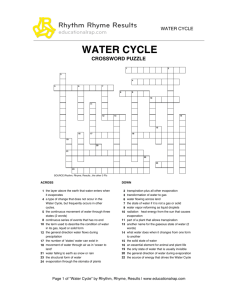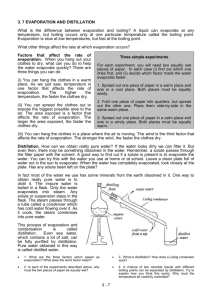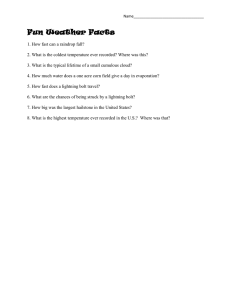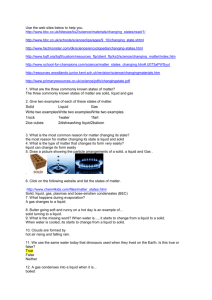Evaporation
advertisement
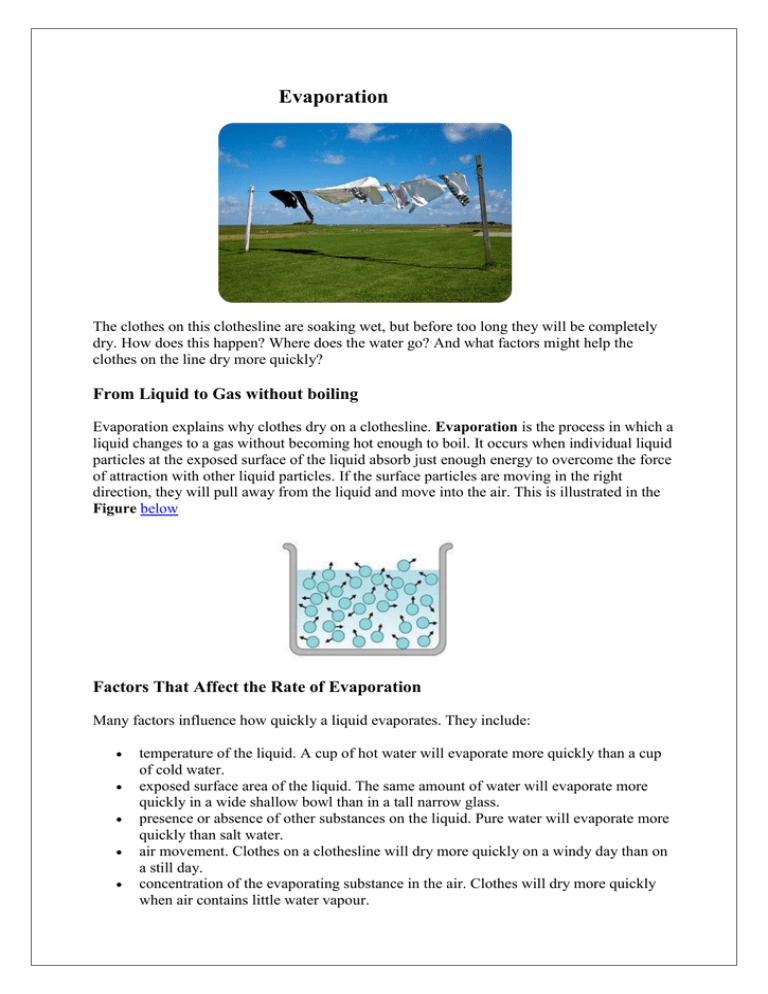
Evaporation The clothes on this clothesline are soaking wet, but before too long they will be completely dry. How does this happen? Where does the water go? And what factors might help the clothes on the line dry more quickly? From Liquid to Gas without boiling Evaporation explains why clothes dry on a clothesline. Evaporation is the process in which a liquid changes to a gas without becoming hot enough to boil. It occurs when individual liquid particles at the exposed surface of the liquid absorb just enough energy to overcome the force of attraction with other liquid particles. If the surface particles are moving in the right direction, they will pull away from the liquid and move into the air. This is illustrated in the Figure below Factors That Affect the Rate of Evaporation Many factors influence how quickly a liquid evaporates. They include: temperature of the liquid. A cup of hot water will evaporate more quickly than a cup of cold water. exposed surface area of the liquid. The same amount of water will evaporate more quickly in a wide shallow bowl than in a tall narrow glass. presence or absence of other substances on the liquid. Pure water will evaporate more quickly than salt water. air movement. Clothes on a clothesline will dry more quickly on a windy day than on a still day. concentration of the evaporating substance in the air. Clothes will dry more quickly when air contains little water vapour. With the interactive animation at the URL below, you can explore how three of these factors affect the rate of evaporation of water. http://techalive.mtu.edu/meec/module01/EvaporationandTranspiration.htm Evaporative Cooling Did you ever notice that moving air cools you down when you’re hot and sweaty? For example, if you sit in front of a fan, you feel cooler. That’s because moving air helps to evaporate the sweat on your skin. But why does the evaporation of sweat cool you down? When a liquid such as sweat evaporates, energetic particles on the surface of the liquid escape into the air. After these particles leave, the remaining liquid has less energy, so it is cooler. This is called evaporative cooling. Q: On a hot day, high humidity makes you feel even hotter. Can you explain why? A: Humidity is a measure of the amount of water vapour in the air. When humidity is high, sweat evaporates more slowly because there is already a lot of water vapour in the air. The slower evaporation rate reduces the potential for evaporative cooling. Summary Evaporation is the process in which a liquid changes to a gas without becoming hot enough to boil. It occurs only at the exposed surface of a liquid. Many factors affect how quickly a liquid evaporates, including the temperature of the liquid and air movement. When particles evaporate from the surface of a liquid, the remaining liquid is cooler because it has less energy. This is called evaporative cooling. Explore More Evaporation plays an important role in the water cycle, which recycles Earth’s water. Explore the water cycle with the interactive animation at the following URL. Then answer the questions below. http://earthguide.ucsd.edu/earthguide/diagrams/watercycle/ 1. What are two sources of water for evaporation in the water cycle? 2. After water evaporates, what happens to it next in the water cycle? 3. Predict what would happen to the water cycle if there were no evaporation. Review 1. 2. 3. 4. Define evaporation, and describe how it occurs. List four factors that influence the rate of evaporation. What is evaporative cooling? Why does it happen? Dorrence mopped the floor and now it is wet. She wants the floor to dry more quickly, so she plugs in an electric fan, aims it at the floor, and turns it on. Do you think this will help the floor dry faster? Why or why not?
